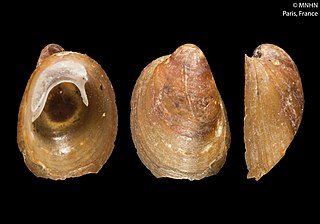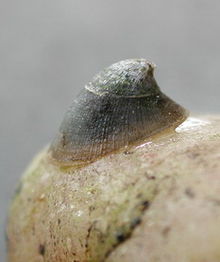
Lake Tanganyika is an African Great Lake. It is the second-largest freshwater lake by volume and the second deepest, in both cases after Lake Baikal in Siberia. It is the world's longest freshwater lake. The lake is shared among four countries—Tanzania, the Democratic Republic of the Congo, Burundi, and Zambia—with Tanzania (46%) and the DRC (40%) possessing the majority of the lake. It drains into the Congo River system and ultimately into the Atlantic Ocean.

Limpets are a group of aquatic snails with a conical shell shape (patelliform) and a strong, muscular foot. This general category of conical shell is known as "patelliform" (dish-shaped). Existing within the class Gastropoda, limpets are a polyphyletic group.

The Patellogastropoda, common name true limpets and historically called the Docoglossa, are members of a major phylogenetic group of marine gastropods, treated by experts either as a clade or as a taxonomic order.
Ancylus Lake is a name given by geologists to a large freshwater lake that existed in northern Europe approximately from 9500 to 8000 years BC being in effect one of various predecessors to the modern Baltic Sea.

Ancylus is a genus of very small, freshwater, air-breathing limpets. They are aquatic pulmonate gastropod mollusks in the tribe Ancylini within the family Planorbidae, the ram's horn snails and their allies.

Planorbidae, common name the ramshorn snails or ram's horn snails, is a family of air-breathing freshwater snails, aquatic pulmonate gastropod molluscs. Unlike most molluscs, the blood of ram's horn snails contains iron-based hemoglobin instead of copper-based hemocyanin. As a result, planorbids are able to breathe oxygen more efficiently than other molluscs. The presence of hemoglobin gives the body a reddish colour. This is especially apparent in albino animals.

Theodoxus fluviatilis, common name the river nerite, is a species of small freshwater and brackish water snail with a gill and an operculum, an aquatic gastropod mollusk in the family Neritidae, the nerites.

Latia neritoides is a species of small freshwater snail or limpet, an aquatic gastropod mollusc in the family Latiidae.
Ferrissia neozelanica, also known as Gundlachia neozelanica, is a species of minute freshwater limpet, an aquatic pulmonate gastropod mollusk, or micromollusk, in the family Planorbidae.
The Rocky Mountain capshell is a species of freshwater snail in the family Acroloxidae, the river limpets. It is the only member of the family found in North America.
Burnupia is a genus of small freshwater snails or limpets, aquatic gastropod mollusks that are traditionally placed in the family Planorbidae.

Leptoxis ampla, common name the round rocksnail, is a species of freshwater snail with a gill and an operculum, an aquatic gastropod mollusc in the family Pleuroceridae.

The plicate rocksnail, scientific name Leptoxis plicata, is a species of freshwater snail with a gill and an operculum, an aquatic gastropod mollusk in the family Pleuroceridae.

Rhodacmea filosa, the wicker ancylid, is a species of small, air-breathing, freshwater snail or limpet, a pulmonate gastropod in the family Planorbidae.

Chaetogaster is a genus belonging to the segmented worms (Annelida). It is classified in the family Naididae in the order Oligochaeta. These are ca. 2–25 mm long transparent worms that are very common in fresh water and often form chains of individuals through asexual multiplication.

Acroloxus lacustris, or the lake limpet, is a small freshwater limpet or snail, a species of aquatic gastropod mollusk in the family Acroloxidae.

Lottia scabra or the rough limpet is a species of sea snail, a true limpet, a marine gastropod mollusk in the family Lottiidae.

Testudinalia testudinalis, common name the common tortoise limpet, is a species of sea snail, a true limpet, a marine gastropod mollusk in the family Lottiidae, one of the families of true limpets. It is commonly known as the plant limpet or tortoiseshell limpet.

Emarginula crassa, the thick slit limpet, is a species of sea snail, a marine gastropod mollusk in the family Fissurellidae, the keyhole limpets.
Laevapex fuscus, the dusky ancylid, is a species of small, freshwater, air-breathing limpet, an aquatic pulmonate gastropod mollusc or micromollusc in the family Planorbidae, the ram's horn snails and their allies.

















